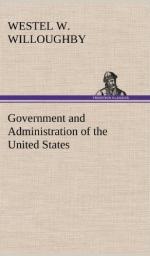_#The National Museum, Smithsonian Institution and Bureau of Ethnology.#_—In 1829 James Smithson, bequeathed by his will the whole of his property, something over half a million dollars, “to the United States of America to found at Washington, under the name of the Smithsonian Institution, an establishment for the increase and diffusion of knowledge among men.” This fund held by the United States now amounts to $702,000 yielding six per cent, per annum. In 1846 Congress determined to devote this gift of Smithson to the founding and support of a museum. The National Museum was established in 1846, and is supported by annual appropriations by Congress.
In 1879 Congress created a special bureau under the Secretary of the Smithsonian Institution, to be called the Bureau of Ethnology, to make researches in North American anthropology. This work is supported by annual appropriations. The National Museum, Smithsonian Institution and Bureau of Ethnology, though distinct institutions[1] are under substantially the same management. Their reports are of great scientific value.
_#The Librarian of Congress.#_—The Librarian of Congress is an independent officer and reports directly to Congress. He has complete control of the Congressional Library, now situated in the Capitol building. The books now collected in this library have been purchased from time to time by Congress. There is a law requiring that two copies of every book, pamphlet, newspaper, photograph, etc., copyrighted in the United States, shall be sent to the Congressional Library. It thus receives large and valuable additions yearly. The Library now numbers over half a million volumes. A new building for the library is in process of construction, and it will have cost when completed between seven and eight million dollars.
[Footnote 1: A valuable and suggestive paper on The Origin of the National Scientific and Educational Institutions of the United States, by Dr. G. Brown Goode, Assistant Secretary of the Smithsonian Institution, was published by the American Historical Association. Vol. IV, Part 2. G.P. Putnam’s Sons, New York, 1890.]
CHAPTER XI.
The Federal Judiciary.
In forming the Constitution the framers of our government were controlled by the principle that the powers which belong to all governments can be most safely and satisfactorily exercised by dividing them according to their nature among three separate branches, the executive, the legislative, and the judicial. Under the Articles of Confederation this maxim of government had been disregarded. The old Continental Congress had been given under that plan, not only legislative powers, but also those executive and judicial powers which the States had yielded to the central government.
The lack of a Federal judiciary was, as Justice Story says, “one of the vital defects of the old confederation.” Hamilton, the expounder of the Constitution, said: “Laws are a dead letter without courts to enforce and apply them.”




